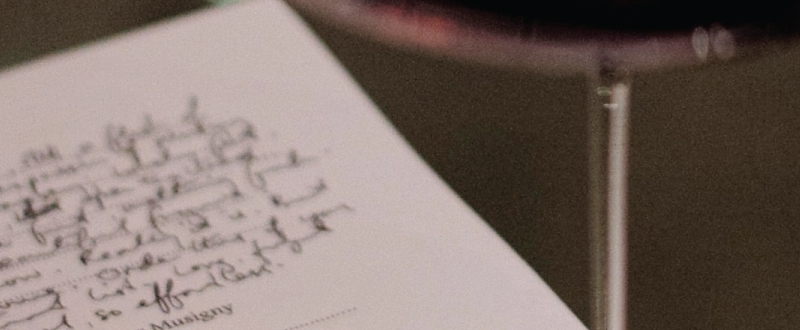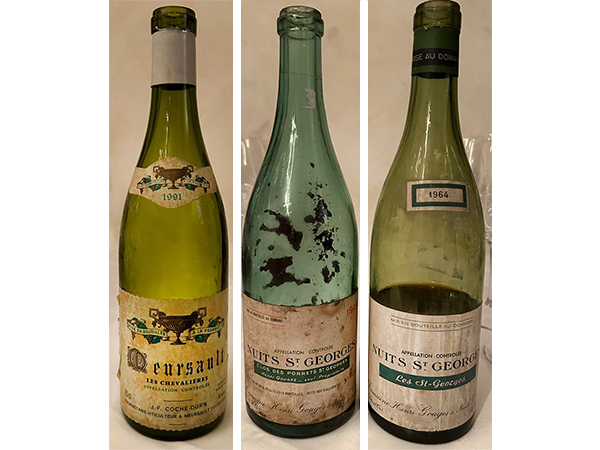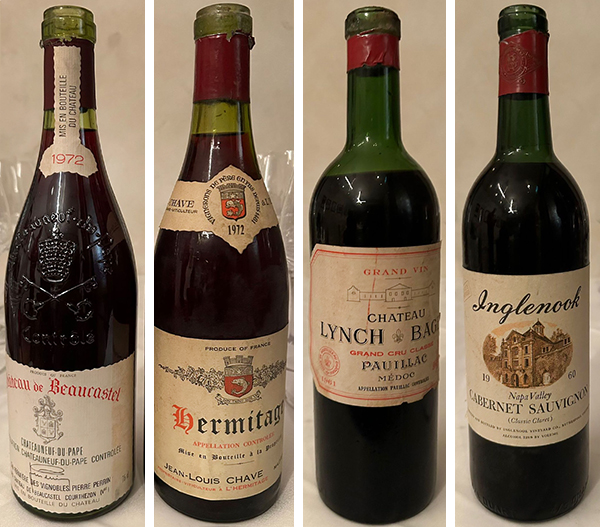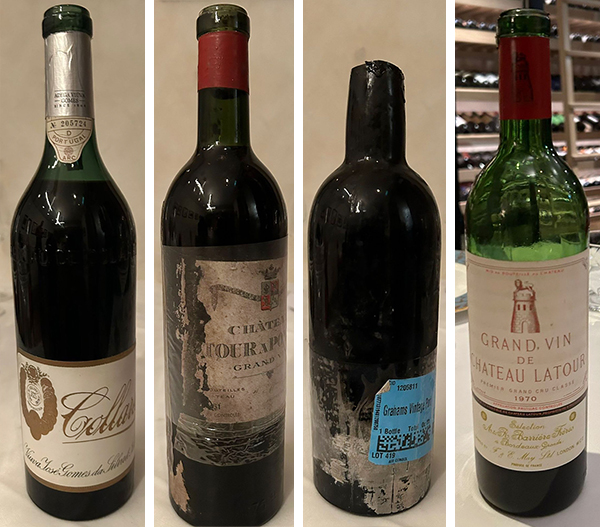

© Linden Wilkie, 24th March 2023
My time in Hong Kong this trip kicked off with one of those perfect single table dinners with a small group of friends, that went on into the wee hours of the morning. The combination of the BYO theme – “old and interesting” – and the broad range of wine interests within the group, ensured an enthralling flow of bottles, high energy levels, with all the bottles, back up bottles, and more… opened.
The hit rate was very high. Indeed, for the majority of wines we had I have not had or could not imagine better examples. An old adage comes to mind – there are no great old wines, only great old bottles. And with old wines, provenance trumps everything in improving your chances.
My tasting notes (which ran out a few bottles shy of the evening’s finish) follow, and below that you will find some mature stock listed, all of which is “ex-domaine” / “ex-château” late release wine.
But first, a few comments on the dinner highlights.

The ‘91 Meursault ‘Les Chevaliers’ showed the sheer class that has made Coche-Dury famous, with an intensity and balance we should not reasonably expect from a lieu-dit village-level Meursault in a 32 year old vintage undistinguished for whites. (My colleague Louis wrote eloquently about this amazing domaine last week).
The pair of Henri Gouges wines were the second coincidence of the day for my friend S.G. and I. In the morning he was about to message me to discuss what to bring to the dinner when he looked up from his phone – in a mall – and there I was standing. We discussed all sorts of wines, but did not discuss Burgundy. Yet we both brought Nuits St Georges from Domaine Henri Gouges, a total coincidence. (Time for a lottery ticket purchase perhaps). The ’64 Les St.-Georges, like many of that vintage with richness but lower acidity, is in a fade now, but the ’45 Clos des Porrets St.-Georges – a Gouges monopole – was in striking health, and everything you could want in a glass of mature red Burgundy. It’s a reminder that old Gouges (an early domaine bottler) and Nuits-St.-Georges shouldn’t be overlooked.

It was an effortless segue from mature red Burgundy to mature red Rhône, with the ’72 J-L Chave Hermitage, which showed Syrah’s red fruit side, bright acidity and elegance. It’s bigger vintages that have the fame and that are the darlings of the fine wine market, but Gérard Chave’s juicy-bright purity, delicacy and finesse are captured even more ably in a more moderate year like 1972, a vintage in which Hermitage was arguably the most successful appellation in France. The Chave was paired with a southern neighbour – ‘72 Ch de Beaucastel, also a really well preserved fresh bottle. Well, you know I love vintage pairs! – and this one contrasting the plush round shape of old the old Châteauneuf-du-Pape so well against the racier, more elongated shape of the Hermitage.
What was fascinating about the next pair – ’61 Lynch Bages and ’60 Inglenook Classic Claret – is just how conceptually interchangeable they were. Inglenook’s John Daniel Jr. was Napa’s greatest winemaker in this era in my view. As I tasted these two side by side, I imagined that if they had been served blind and told that one was claret and one was Napa I’m sure would have picked them the wrong way around. The Lynch Bages, baby-Mouton-Rothschild like in its intense black fruit and mintiness, would have had me thinking about the best of late ‘60s to late ‘70s Napa, while the more leafy and elegant Inglenook was so aptly named ‘Classic Claret’ by Daniel.

The most interesting wine of the night was the ‘31 ‘Collares’ from Viuva José Gomes da Silva & Filhos. Colares (as it is spelled today) is in Portugal’s Altantic coast, by Sintra, and at the time this ’31 was made it was a thriving wine district covering hundreds of hectares. Colares was renowned for its fine, long-lived reds made from the Ramisco grape, ungrafted because phylloxera cannot survive the sandy soils there. Just 20 hectares still exist today, the rest now a sprawl of houses by the sea. I’m absolutely drawn to this idiosyncratic and unique wine. S.T., who shared his bottle of this ’31, said its maturation was decades long, before it was first released some time in the 1970s! This is one of those stories where one of the world’s really interesting wine regions came to within a hair’s breadth to extinction. So, if you are travelling to Portugal, make sure to find a bottle of Colares. (There’s a white too).
The three most outstanding bottles of the night had in common unbeatable provenance. ’61 Latour à Pomerol is a bucket list-level wine at the level of ’45 Mouton, or ’47 Cheval Blanc, yet an order of magnitude rarer. The impression of intensity, quality and personality were compounded this evening by the sheer perfection in condition of this bottle, which had lain in the now late British wine merchant John Avery’s cellar most of its life, and my friend C.A.’s cellar since then. This wine produced the only few seconds of silence around the table of the whole night.
The ’48 Graham’s was reminder no one at our table needed that the best of vintage port sits in the front rank of fine wine, and can be as compellingly beautiful as anything. Examples with as high a reputation and rarity today as the likes of this ’48 Graham’s are not inexpensive, yet if they were also fashionable in even just a few more fine wine drinking circles, in my view their quality supports more epic-level prices. Yet, aide from Noval Nacional, this isn’t the case today. So, don’t tell anyone. Shhhhh.
Finally, amongst the waves of encore wine flights this evening, was a show-stopping bottle of ’70 Latour. This wine has at times perplexed over the years, as its style is in the more muscular and brooding expression of Latour’s personality. Well stored bottles of it have always come across as surprisingly youthful, but at times just too tannic, or reticent. But not this evening. Everything came together in this bottle, revealing a very complete Latour at the level of the very best vintages. No surprise then that this bottle lived most of its life in a University of Cambridge college cellar.

1991 Meursault ‘Les Chevaliers’, Domaine Coche-Dury
Bright fresh gold colour; a rich and spicy aroma, that Coche reductive touch is there, but this is open and expressive on opening, the nose giving an exotic touch of almond and pineapple; the palate is round and creamy, with impressive concentration, sweetness and oiliness, and an umami note as the acidity and oak tuck the wine in to a slightly tighter finish following the generous middle. Even by the standards of Coche-Dury, this bottle is impressive, given the vintage and age. A lovely wine, and from a bottle that has enjoyed a happy life in the cellar.
92
1945 Nuits-St.-Georges ‘Clos des Porrets St.-Georges’
Domaine-bottled, ‘seul propriétaire’
A limpid and pale tawny colour with ruby notes; a great smoky mature nose, leather, earth, spices, sous bois and sweetness; an elegant and silky attack, red fruit, leather, earth and spice, real purity of flavour and weight, sweet supple tannins to frame it. It continued to expand positively in the glass, great length, and an alluring perfumed smokiness. Fantastic bottle.
95
1964 Nuits-St.-Georges ‘Les St.-Georges’
Domaine-bottled
Slightly deeper in shade than the ’45, and more garnet-tined with a yellowing tawny rim; sweet on the nose, and masked by some oxidation, but still in play; the boldness of ’64 shapes the low-acid palate, there is still some sweetness, but the fruit has now turned a little raisin-toned, and there are some notes of plastic masking the aromas. The wine tastes correct, offers some pleasure, but is in its final days of decline.
86
1971 Barolo, Fratelli Oddero
Faded ruby-garnet with a fire rim, the appearance is bright, clear and promising; sweet on the nose, lifted by some VA on first pouring, there is also some brett; sweet red fruit and nice balance on the palate, but while the VA blew off sufficiently the brett also expanded and dominated what was otherwise quite nice.
82
1972 Hermitage Rouge, Domaine J-L Chave
Domaine-bottled, high fill.
Lovely bright clear colour, pale clear ruby; sweet and meaty on the nose, white pepper and red fruit, this pure and beautifully expressive; bright and juicy on the palate, the fine-boned structured is well-covered, this is so elegant, a hint of bay leaf in with the white-peppered red fruit, stylistically this is an easy segue from the red Burgundies just tasted.
94
1972 Châteauneuf-du-Pape Rouge, Château de Beaucastel
Domaine-bottled, high fill.
Bright full mature ruby-garnet; perfumed sweetness on the nose; this is sweet, lush and vibrant on the palate, red cherry scented fruit, and a nice melting, glycerin-textured feel, it is a mid-weight Beaucastel, impressively fresh and bright for its age, that age felt really only on the orange-rind laden frame that is beginning to dry, but the aftertaste returns sweetly. Lovely wine.
91
1961 Château Lynch Bages
Château-bottled, mid-shoulder fill.
A really full colour, semi-clear garnet, mature rim; sweet dark blackcurranty nose, with a touch of eucalyptus or mint, the ripe rich nose follows on on the palate which is intense, with winegummy concentration of dark fruit, and good length. A Pauillac family resemblance is there with ’61 Mouton.
92
1961 Inglenook Classic Claret
Top-shoulder level
Mid-garnet, fine colour; sweet, leathery, smoky, leafy; lush, sweet, very balanced, fragrant and long, fresh yet mature, a lovely wine with a sweet finish, the tannins are just a little rustic, with a note of demerara sugar. With time in the glass the wine grew and filled out more to cover that sweet note with a well-knit expression of fine dark fruit, leafiness, spice and nuance. A really lovely wine.
93
1961 Château Latour à Pomerol
Château-bottled, ex-John Avery cellar, base of neck level
Semi-clear deep garnet, bricked at the rim; an intense nose of dark fruit infused with sandalwood and potpourri; sweet, lush, mouthfilling, gently spicy and oh so complex, this is just so “other level”, a touch of sweet herb and smoke, dried roses at the end, but every element here is subtle and shape-shifting in this thick-textured, melting and exotic wine.
100
1964 Château Rausan-Ségla
Château-bottled
Bright light garnet; the dusty sweet nose is a touch superficial at first, with notes of fudge, coconut, and egg yolk-rich baked custard mixed in with the fruit; bright sweet and melting on the palate, this is on the light side in intensity, but it is bright and pleasant and clear in expression, drinking well still.
88
1931 ‘Collares’, Viuva José Gomes da Silva & Filhos
Bright and strikingly deep garnet; an aroma of rich dark fruit and something distinctive, like hot engine oil or grease in old machinery working hard; the palate is intense, saline-edged dark-fruit flavour in pastille form, with a melting old-fashioned grip that frames the finish. There’s a sense of the slow oxidative maturation, as if imperceptibly gradual evaporation has contributed to its essency intensity at just 11% stated alcohol by volume, and frozen in time sense of stability. A really intriguing wine.
92
1927 Bastardo Vintage Madeira, d’Oliveira
A pale and hazy green-olive tawny; the nose is lifted, bright and off salted toffee almonds; intense on the palate, woody, salty and dry, it’s texture is a little coarse, briney. This bottle, just opened, perhaps needs a few more weeks to shed its ‘bottle sickness’, but otherwise it’s a less good (2014) bottling than I recall tasting in the 2000s.
87?
1948 Graham’s Vintage Port
Oporto-bottled, into neck fill level
Beautifully crystal clear, shimmering rose garnet appearance; so floral and pretty on the nose, sweet fruit, bright and very pure and clear in expression on the nose; super rose-floral expression on the palate too, notes of Darjeeling tea, it comes across almost like whole bunch red Burgundy in its red fruit, tea and florals, but then additionally it is giving a layered feel, with deeper, darker fruit notes and old fashioned English fruitcake richness too. This is completely open, and melting in texture, its gentle grip and glycerin yielding on the palate, and its fine balance, detailed delicacy, and very pretty, scented nature giving an impossibly weightless sensation to what is, after all, a fortified wine. This is the kind of port port lovers dream about.
98
1989 Château L’Eglise-Clinet
A deep colour with a mature rim; compact, closed and sweet on the nose; the palate showing cherry compote, herbs and dark chocolate. Sweet, intense and solid in feel, it is classically typical late great Denis-Durantou Eglise-Clinet, a touch square, and tightly wrapped up, but brimming with intense fruit, and still somehow elegant.
92
1970 Château Latour
A high-fill level bottle ex-King’s College Cambridge cellar
A very deep colour and tone; sweet, biscuity and unbelievably fresh vibrant Latour nose; really concentrated, broodingly deep, and incredible intact, fresh and expressive and clear for 53 years old, biscuity, leafy, with toasted sesame notes in with the dark Cabernet-led fruit taste, lovely sweetness, mineral-laden. A remarkable bottle.
99
